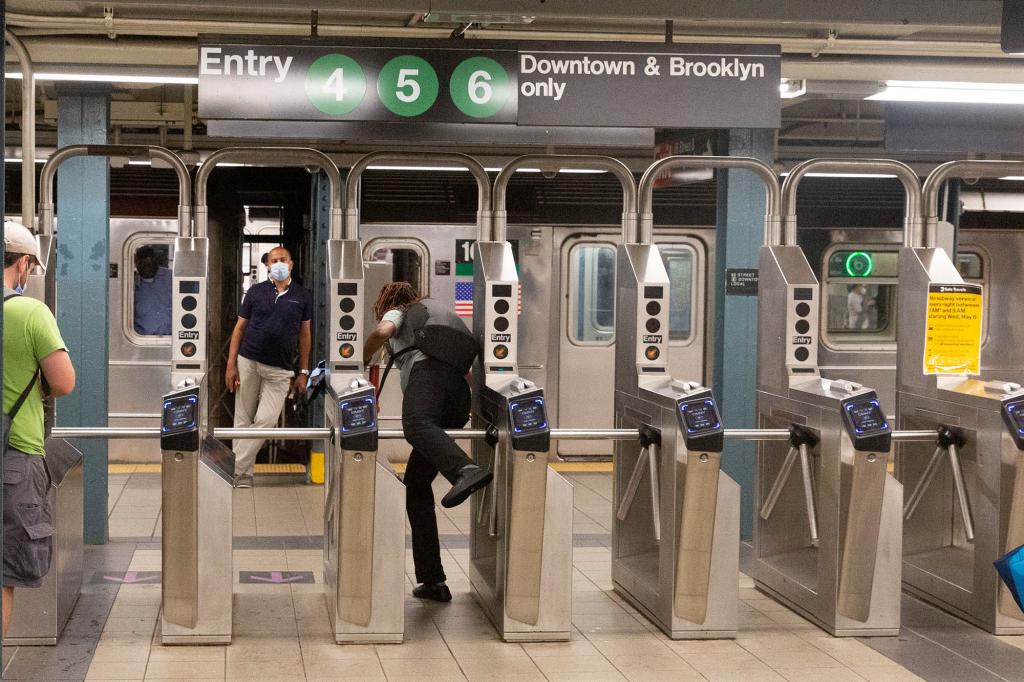With ridership at about 60% of pre-COVID normal, the state-run Metropolitan Transportation Authority has huge problems getting people back on trains right now and faces huge budget deficits in the future. There’s a place where these two problems crash into each other: fare evasion. The MTA is creating an expert commission to advise on how to get people to pay up before it’s too late.
MTA chief Janno Lieber laid out the facts this week: “Law-abiding New Yorkers . . . observe too many of their neighbors slip through an open emergency gate, duck a turnstile or walk onto an MTA bus without paying.” More than 12% of subway “customers” are evading the fare, up from 3% in 2018. On buses, a third of passengers are free-riding.
We all pay the financial cost of fare evasion, in either higher fares or taxes: The MTA will lose half a billion dollars this year to stolen fares.
This cost will grow as evasion reaches what Lieber fears is a “tipping point” because customers are so “demoralized” by watching other people get in free. “Why should I pay when so many others don’t?” they think.
As we’ve seen over the past two years, once a culture of respecting the law and other people is lost, it’s hard to get it back. New York is welcoming a whole generation of newcomers and maturing teenagers who are learning that it’s OK not to pay.
What of the common argument that fare evasion is a crime of poverty? No: It’s a crime of anti-social behavior. The vast majority of poor workers pay their fare. As Mayor Eric Adams has said multiple times, New York has a program — funded by the city — through which poorer residents can receive half-fare MetroCards.
Failing to enforce the law, by contrast, harms poor riders who must contend with crime and disorder. People willing to flout small laws disproportionately flout bigger ones.

Twice last month, cops stopped people for breaking other rules in the subway, walking between cars and lying on the platform, and found they were carrying loaded guns.
The people who take over the corners of subway cars and intimidate other passengers by openly smoking pot or blasting music, daring other customers to stop them — how do you think they got into the subways in the first place?
As Lieber says, “When riders see people breaking the rules — smoking, public urination, open drug use, vandalism — they wonder: What else might that person do to me?”
Of course, mentally ill and homeless adults need help. In the meantime, they can’t drive away customers who are using transit as transportation.
Yet in a recent Partnership for New York City survey, nearly three-quarters of commuters say the trains are less safe than they were pre-COVID, and nearly half of commuters say that “not enough is being done to address turnstile jumping.”
If transit advocates want people to take the train, they have to listen to what riders and former riders are most concerned about.
This does not mean that anyone should go to jail because he forgot his MetroCard. “Failure to pay $2.75 . . . should not change the trajectory of anybody’s life,” said Lieber. Almost all fare evaders receive a civil summons anyway, rather than face misdemeanor arrest.

Some things the commission should consider:
1) A formal warning system. Police claim they give out tens of thousands of warnings each year, in lieu of issuing summonses — but they have no record of such warnings. For a first offense, police could issue a civil ticket that carries no penalty, so that they know whether someone is committing her first offense or her fiftieth.
2) For people who have piled up multiple civil summonses, community service in lieu of a misdemeanor arrest. A community-service requirement for people jumping subway turnstiles because of homelessness or drug addiction could be the first step toward a job and a functional life.
3) More enforcement at racially diverse stations. Police should avoid stings at stations where the majority of customers are black or Hispanic, such as in central Brooklyn or the south Bronx. Instead, as former Police Commissioner Bill Bratton once did, do them at major hubs, and catch everyone who doesn’t pay.
Consistent enforcement won’t catch more people in a dragnet. After a while, as Bratton demonstrated, it will catch fewer people — because people will know not to chance it.
Nicole Gelinas is a contributing editor to the Manhattan Institute’s City Journal.

